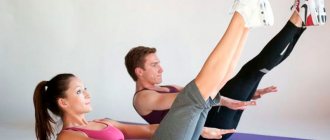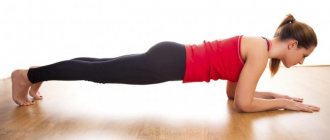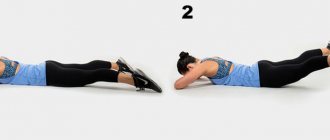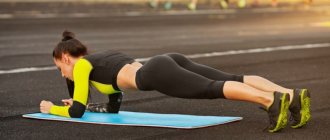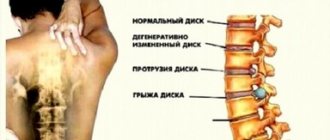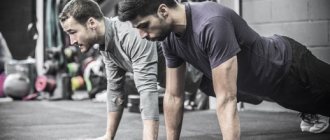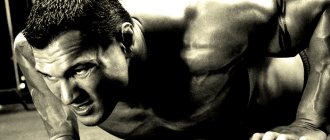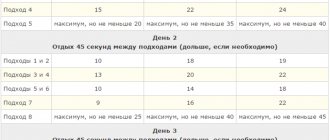Air squats
Almost all people with a sedentary lifestyle have weak leg muscles.
Joints suffer from laziness of muscles. This is why people after 40 or earlier complain of knee pain. Most of my couch potato clients begin strengthening their leg muscles with the air squat exercise.
Sometimes people weakened by a sedentary lifestyle start with chair squats and progress first to air squats, as in this video:
Often, from five sets of eight squats the next day, beginners over forty have sore leg muscles.
When my clients reach the level of 5x12 air squats, I complicate the exercise: I add a 5-kilogram dumbbell.
What if you continue to increase the number of squats?
Squat experiment
Oleg Gritsai
Hello, FiS! I've been discharging you for 24 years. I keep it. I collected the part of the “Golden Library of Health” that interests me. The magazine has the highest rating. I bow to you for steadfastly not printing advertisements. I understand how difficult it is.
About Me. 68 years old. Working pensioner. I have an extremely negative attitude towards traditional medicine. Never took pills. I consider physical activity to be one of the components of a healthy lifestyle. I base them on daily morning exercises. I spend at least 2 hours on it, including: 40 minutes for an active massage of the whole body, 40 minutes for a set of exercises with a base that has been proven over the years and replaceable additions. I perform some exercises in yoga asanas (I came up with this myself to save time).
Next I have running, iron, and water treatments. Well, in life I prefer to walk rather than drive. I don't use the elevator. I love skiing, cycling, swimming (I go to the pool twice a week).
Having received the FiS, I first look through it, then I read almost everything with a marker in my hand. I return again to the one that interests me and re-read it, sometimes many times. If I decide to test something on myself, the journal becomes desktop for the duration of the test.
And now, for the eighth month, No. 7 of “FiS” for 2007 has been on the table. And I was interested in a letter from Sergei Korchagin and an article by Heinrich Epp, which talked about the benefits of squats. These squats attracted me as an alternative to running (which is dependent on the weather), as well as protection against sciatica, with which I have had a long-standing difficult relationship. So I decided to share my experience of squats with FiS.
I started with 20 squats a day. After 1.5 months I reached 100, where I “sat” for 2 months. Then I did squats 200 times for 1 month, 300 times for another 1 month (although by the end of that month I had already tried squats 600 and 700 times). Then I decided to stop at 500 squats, but then it exploded, and I began to easily squat 1000 and 1500 times, and after 20 days I tried to squat even 2000 times.
The pace is always the same: 100 squats in 4 minutes. But the pulse... Here many thanks to E. Milner, who in No. 8 of “FiS” for 2007 convincingly warned the elderly and hypertensive patients against squats. I decided that my biological age is not a hindrance, but hypertension is - I’ve had it almost since childhood, I seriously played sports with it, I got used to it, I don’t notice it and I can assume that it doesn’t exist. Moreover, my heart never hurt. However, understanding the seriousness of the warnings, I decided not to push the squats to the maximum load. And train, be sure to monitor the number of squats, time spent, as well as heart rate before and after squats (immediately after the end of the workout and an additional 3.5 minutes later). I write down all this data in a notepad indicating the date and time, so that I can analyze it later.
So, about the pulse. If Heinrich Epp’s (let me remind you that Heinrich did 800 squats, the frequency of which was 100 times in 4 minutes) was 160 beats/min, then under no circumstances did my heart rate during squats exceed 120 beats/min. Including after 1500 and 2000 squats. True, I measured the pulse not in 10 seconds, like Heinrich Epp, but in 15 (I think this is more accurate), multiplying accordingly not by 6, but by 4. Usually after squats, the pulse was 105-115 beats/min. As training progressed, it even decreased, despite the increase in loads.
I also measured my blood pressure. True, I only started doing this when I started squatting 1000 and 1500 times. Well, I don’t like to measure it! Usually I have it somewhere around 170/95. 10 minutes after 1000-1500 squats it is 10-30 mm lower than the value before squats.
I also measured my blood pressure after running and swimming. I noticed the same trend - the pressure is decreasing! But after 2000 squats it increased by 20 mm. At the same time, immediately after finishing 2000 squats, the pulse was 115 beats/min, I felt normal, I could continue squats further.
From this I conclude that 2000 squats at the achieved level of fitness is too much. And the tonometer catches it earlier than the stopwatch that measures the pulse.
How do I feel about how I feel after 7 months of squats? Perhaps it has improved. When walking, especially uphill, I felt lighter, but I can’t say that I’m dancing or that wings have grown behind my back.
Like this. I probably won’t experiment with squats anymore: I’ll limit myself to 750 squats daily for 30 minutes - on days when there is no running, skiing, cycling or anything else.
And for myself, from this experiment I concluded: if you can’t, but really want to, then you can, but very carefully.
Wishes of "FiS": more alternative opinions, discussions, critical reviews - in general, more wit. Don't give in to advertising. Keep it up. We love you.
Oleg Grigorievich GRITSAY, Kharkov, Ukraine
back
Monthly training program
For those who want to get the effect in a short time, you can use squats for weight loss, scheduled for a month. In addition to getting rid of excess weight, your buttocks will become more elastic and your legs will be slimmer, while your metabolism and tone of the body as a whole will improve. The basis of this program is a specially developed scheme for the correct execution of squats for every day. And to complicate the task and use as many muscle groups as possible, you can do squats for weight loss together with a barbell or dumbbells. Upon completion of this course, it will turn out that 250 squats were done in 30 days.
The program itself implies that on the first day you need to do 50 squats, then gradually increasing their number. There are also days for rest during the program. Even before you start directly training for the buttocks, the program for which is scheduled for a month, it is recommended to first prepare the body: start with a smaller number of squats and spend time warming up each time. This approach will warm up and prepare the muscles for the load. In addition, the 30-day program does not oblige you to do the entire prescribed volume of squats at a time; you can divide the amount into several approaches with a frequency of 1-2 minutes.
You can print out and hang in the place where the training takes place a schedule of squats in the form of table 2. You can also mark the days passed there, which will motivate you not to stop there.
Don’t be surprised if after the first workout you will experience pain and discomfort in your muscles. This will pass soon when the muscles get used to such loads. A hot bath will help relieve pain, but your exercise program should not be delayed.
What can you use to make your squats more effective?
After the body adapts to the load, you can add new elements and exercises, change the approach a little - in general, experiment.
Photo: istockphoto.com
Stanislav:
To make squats more effective, it is necessary to periodize the loads, train using different sports equipment, and increase the volume and intensity of exercises.
Low start: 7 effective exercises for the lower body from Yulia Kanakina
It is worth remembering that sooner or later the body adapts to any load. Therefore, in order to maintain progress, you will have to increase the intensity.
Four examples of home exercises
shutterstock.com
- Classic squats
View this post on Instagram
A post shared by REBOOT interval training (@reboot.ru) on Oct 20, 2022 at 8:12am PDT
In a standing position, where the feet are positioned pelvis-width apart and the arms are along the body, a squat is performed while inhaling. During the movement, the pelvis is pulled back, and the legs at the knees form an angle of 90 degrees. As you exhale, there is a slow rise to the starting position. To maintain balance, straight arms are extended forward, folded into a lock.
- Narrow Squat + Jumping Jack
In a standing position, in which the feet stand touching each other, a squat is performed, turning into a jump. During the last element, your feet land shoulder-width apart and your hands clap overhead. Then the body returns to its original position.
- Wide leg squat or plie
The exercise is performed in this way: the legs are spaced further apart than shoulder width, the toes in the squat “look” forward and slightly to the sides, forming a right angle.
- Plie with touching the floor alternately
The legs are also in a wide stance, but at the moment of the jump one of the hands touches the floor, then the same manipulations are done, but the other hand is applied to the floor.
What happens if you squat 100, 200 or 300 times every day?
On the Internet we find alluring photos, the author of which shows how he performs some kind of “magic exercise” every day and after a month a “magical transformation” occurs to him. Some of these authors go as far as doing thousands of squats or push-ups a day, and a month later they post a before and after that shows a shocking difference. The photos show that fat was burned, muscles grew, the waist became narrower, the stomach disappeared and other miracles.
Harmless “Sissy” squats with your body weight can damage the knees of a person with a large body weight, in just 1 workout! What can we say about the month?
In 100% of cases, such “transformations” are not true. What is the deception? Yes, the fact is that the visual effect for a month (or another period) is achieved as a result of some actions, but is presented as a result of other actions. I won’t talk about Photoshop effects, manipulations with light, tanning, makeup and stomach retraction, because this is just the tip of the iceberg!
Within a month, abs and muscle definition appeared!
Any, even the most useless exercise, combined with a diet will lead to fat loss within a month. Without exercise, simply by cutting calories, we will get weight loss and definition. By adding walking or squats, we will of course get some acceleration of progress. But this does not mean that progress was achieved due to a miracle exercise. Mostly the diet worked, movement helped the process a little.
Without training, muscles will be small, but the “cubes” and relief will still appear. The abdominal press is a muscle that works in everyday life, so many people don’t even train their abdominal muscles, but they are still present, on their own. Everyone has abs - under a layer of fat, this is physiology. “Relief” is possible without exercise. With exercise, muscles grow, and when combined with diet, the results are much more convincing. The results of a person with large muscles look impressive, while the results of a simply thin person are more “skinny”. But for the average person this doesn’t matter, he has already opened his mouth and ran to do 100 squats a day.
In a month, doing squats (push-ups) pumped up my muscles!
For a man weighing 70 kg, squats with a 20 kg bar are easier than for a 120 kg man to squat without a bar!
Constant muscle growth is a response to the progression of loads. For example, we did 15 squats, it was hard, and our muscles grew a little. After all, they had never received such a load before. The next workout we do 15 squats again, but this is already easy. 15 squats with additional weight are required. But our task is to progress from bodyweight squats. What if you just increased the number of repetitions?
Unfortunately, when the amount increases, only a small percentage of muscle fibers (MF) are involved. These are the fibers that cannot grow, that is, they work on endurance. Squatting on the right leg and then on the left leg will increase the load without applying additional weight.
But we will face another problem - for muscles to grow, they need time to recover. Trying to train legs every day and increase the weights or make it more difficult with your own weight will recruit a large number of MFs. The process of their growth will begin. But hypertrophy or muscle growth is impossible without recovery, and recovery is impossible without reducing or stopping loads.
Therefore, doing 100 squats a day for a person whose own weight is too light will not give muscle growth. This is why athletes of cyclic sports who perform a huge number of repetitions have small muscles.
100-300 squats for a person with a lot of body weight, or trying to complicate the exercise by squatting on only 1 leg, will put a lot of stress on the muscles, they will need to rest for several days, otherwise the muscles will degenerate and this will lead to overtraining. Your muscles, nervous system, immune system will suffer, you can get sick, lose muscle mass, and destroy your health.
Daily squats (push-ups) provided that your own weight is light without falling into overtraining
Below I have attached videos with more effective training programs. Look at them after you read the text to the end. This way we will make sure that these are exactly the programs you need.
You can perform a movement every day without fear of overtraining if your load is 30% of your one-rep max (1RM) or lighter, and you don't reach muscle failure on the sets. For example, your weight is 80 kg and you can squat 10 times with a 100 kg barbell. Then the unweighted squat will be less than 30% of 1RM and you will be able to perform 15 squats with almost no leg muscle fatigue, 10 sets daily. In this case, you can use the squat (or other exercise) for endurance training or to burn calories every day! However, the following program will be much more effective for developing endurance and losing weight:
15 squats + 15 push-ups + 15 abdominal reps. A minute later this “circle” is repeated. Perform 3-10 such circles depending on your level (muscles should not get very tired, “burn” or hurt). This program can be performed daily without fear of overtraining!
To increase muscle mass, a bodyweight exercise program is suitable (use and gradually increase additional weights):
- Workout 1: Pull-ups 5 sets of 10 reps until failure
- Workout 2: Push-ups 5 sets of 10 to failure
- Workout 3: Squats 5 x 10-15 to failure
This approach will give much greater muscle development. However, there are programs that are much more effective. I will leave a couple of video lessons for you (weight training): for increasing and for increasing.
Squats to extend your life
Dmitry, lately we have realized that muscles are a very important part of health and longevity.
First, I’ll take the copy-paste from the link “allasamsonova.ru/mioyadra-priobretennye-vo-vremya-silovoj-trenirovki”:
(Myonuclei acquired during strength training precede muscle hypertrophy and are not lost after cessation of training. This was proven by Bruusgaard J. et al. They also showed that muscle hypertrophy is associated with a significant increase in the number of myonuclei and inhibits the manifestations of muscle atrophy, and myonuclei can serve in as a substrate for long-term biological memory of cells. Due to the fact that the ability to increase the number of myonuclei is impaired in old age, strength training should begin at an early age, and then continue into adulthood and old age."
After even one course of anabolic hormones lasting 4-6 or 8 weeks, even without any training, the number of myonuclei increases, and then, in the long term, if it decreases with age, then we still have a larger supply of myonuclei than a person , who has never been on the course.
At the same time, “Due to the fact that the ability to increase the number of myonuclei is impaired in old age,” we can understand that at a young age, having carried out one competent course of anabolic hormones, not exceeding tens of times the reference values, with full control by a competent endocrinologist (and control of tests by an endocrinologist on the side) of the entire course, as well as a good PCT, we can get:
Muscles that are much more likely to delay sarcopenia even longer than if the same person did not take the course, but trained with exactly the same strength and aerobic load.
Moreover, if a person finds himself in a situation in which his muscles will not experience hypertrophy for a long time, and he loses any part of the muscle mass to the level that he had even before the course of anabolic hormones (for example, he ends up in the hospital with a fracture or a life situation where will be forced to postpone training for a long period of 6-12 months), then due to the fact that his muscle memory is much better and myonuclei are much larger than those of a person who did not take anabolic hormones, he will restore muscle tone and muscle mass much faster.
At the same time, we must also remember the fact that due to the division of myonuclei, with a person weighing, say, 70 kg, and losing mass up to 65 kg, he will lose this mass much longer than someone who has never completed the course.
I relate this particular comment to men, since in the case of men, this method is available as a result of the hormonal system. There is no point in using AS for more than 8 weeks, and more than 1 course for life, there is no harm to health in this case, given the really good work of specialists and their experience, control of tests and the quality of AS and other medications. If a person does not have oncology or other diseases for which AS is contraindicated, then as I understand it, this is a very good option for preserving more muscle mass.
QUESTION: I want to know your opinion about this use of speakers. Is this approach rational for maintaining greater muscle mass in old age and as protection against sarcopenia?
Offtop: I have a friend who practices boxing, and we often sparred. About 2 years ago, he took turinabol without the supervision of a doctor, I don’t know, he drank it for 6 weeks, he didn’t even do PCT, I told him to do it, he used tribulus (you can say placebo). He took tests before and after in March 2022 in vitro and hemotest, everything was restored according to hormones, this is obvious, he did not poison himself with a bunch of drugs and was healthy, but still, this approach is very reckless.
So, he then gained 8 kg (from 70 kg to 78), after the withdrawal he still weighs 72-74, and in competitions he can weigh up to 70. But what I noticed is that after cutting to 70 (it must be taken into account that this is not cutting water in MMA before a fight, but simply cutting weight), he gains 2-4 kg, sometimes a little more, with the same diet , and this is 85-90 percent muscle mass, the relief remains the same.
And also, from that moment on, his punching power increased and this became noticeable after the course, even when he weighs the same 70 kg, and when 72-74 is almost the same, maybe the punch is a little stronger. I don’t understand what caused this impact force, but it didn’t go away after stopping Turinabol.
And yet, if you look at bodybuilders who wisely subjected their body to stress (and not like Roni Coleman killed his body), they really had muscle mass, even after completely retiring from competition, and they do not show signs of a high degree of sarcopenia
Will such a small amount of squats do any good?
In fact, everything is individual, including in training. Of course, 20 squats daily is not much, and the effect will depend on the physical characteristics of a particular person. For those who lead a sedentary lifestyle and do not exercise, the result will not be long in coming. But gym regulars shouldn’t count on noticeable changes.
Photo: istockphoto.com
Stanislav:
The bottom line is that 20 squats a day will be of no use until the body adapts to the physical activity. The time it may take to complete this is several weeks.
Even if muscle mass doesn't increase, will blood flow increase or endurance improve? This also depends on physical data, and also on nutrition. You can increase muscle mass slightly, and endurance will most likely increase only for those who have not previously exercised and squats are their first regular activity.
Why are squats good for runners? Coaches' opinions
Stanislav:
If a person is in good physical shape, then such a load - only 20 squats a day - will not give much effect.
Weeks and squats
- 50
- 55
- 60
- 65
- 70
- 75
- 80
- 85
- 90
- 95
- 100
- 110
- 120
- 130
- 140
- 160
- 180
- 210
- 240
- 270
- 300
- 340
- 400
- 450
As you can see, the author suggests, by squatting 3 times a week, first adding 5 squats a week, then 10, then 20, and then 30 altogether.
It goes on to conclude that if you achieve 600 squats per workout, then this is equivalent to a continuous high-intensity run of 6 km.
In fact, I would not rush to make such comparisons, especially since it is impossible to run 6 km in a high-intensity style, since it will not be possible to maintain high intensity over such a distance.
And if it works, then it won’t be high intensity.
But in any case, the technique has a right to exist, although I would modify it.
